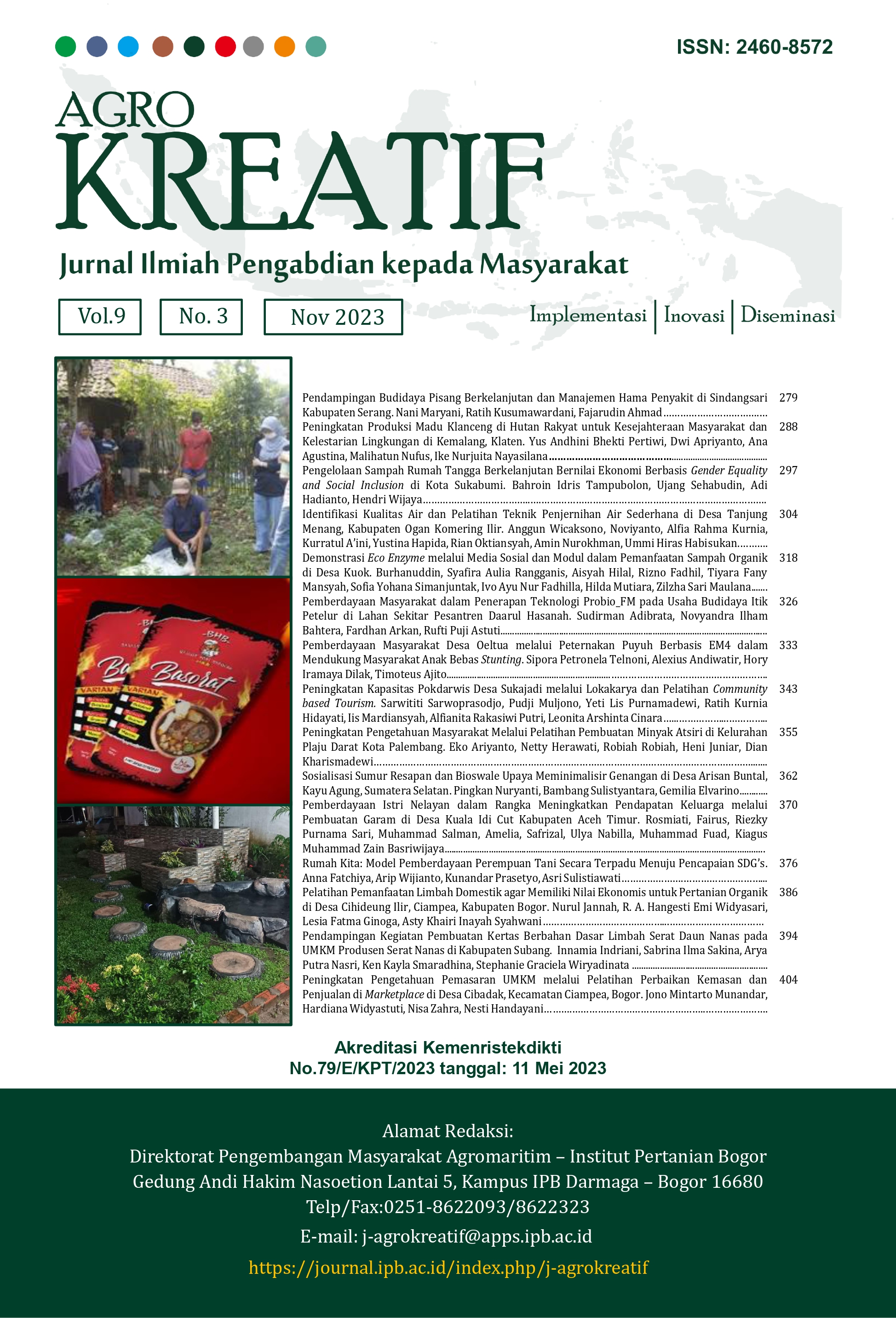Rumah Rumah Kita: Model Pemberdayaan Perempuan Tani Secara Terpadu Menuju Pencapaian SDG’s
Abstract
Peasant women play an essential role in achieving the SDG's. Women's self-capacity must be improved through non-formal education, namely rural development extensions. Community service activities in the Returning Home Lecturers Program were conducted at the Putri Langgeng Peasant Women's Group in Godog Village, Polokarto District, Sukoharjo Regency, Central Java. The aim is to increase women's knowledge, awareness, and skills in terms of increasing digital literacy, namely being able to use cellphones wisely and utilizing the Rumah Sawit application as IPB's innovative work, early detection of stunting symptoms, utilizing yard land to increase family income, preventing and dealing with violence against women and children. The impact of community service helps achieve SDG's goals, namely goal #1, no poverty; #3, good health and well-being; and #4, quality education. The impact of this community service is an increase in household income, with vegetable yields worth an average of IDR 100.000 per month, and catfish harvests from tarpaulin ponds between IDR 300.000‒400.000 per growing season. Other impacts of various vegetables and Calina papaya have been introduced to the village community and outside the village. In the health sector, stunting mats have been used by four Godog Village posyandus as a tool for early detection of stunting.
Downloads
References
Asmadi E. 2018. Peran Psikiater dalam Pembuktian Kekerasan Psikis pada Korban Tindak Pidana Kekerasan dalam Rumah Tangga. Jurnal De Lega Lata. 3(1): 39‒51. https://doi.org/10.30596/dll.v3i1.3136
Astuti I. 2019. Akses Internet di Kalangan Perempuan Masih Rendah. Berita Media Indonesia. [Internet]. [Diakses pada:]. Tersedia pada https://mediaindonesia.com/read/detail/220780-akses-internet-di-kalangan-perempuan-masih-rendah
de Onis M, Branca F. 2016. Childhood stunting: A global perspective. Maternal and Child Nutrition. 7: 5‒18.
Fajaruddin. (2018). Efektivitas Undang-Undang Nomor 33 Tahun 2014 Tentang Jaminan Produk Halal dalam Perlindungan Konsumen. Delegalata Jurnal Ilmu Hukum. 3(2): 204‒216. https://doi.org/10.30596/dll.v3i2.3151.
Farida BY, Sulistiowati B, Hermana. 2011. Internet adoption in Indonesian education: Are female teachers able to use and anxious of internet?. International Journal of Computer Science and Information Society. 9(4): 78‒87.
Huraerah A. 2012. Kekerasan Terhadap Anak. Bandung (ID): Nuansa Cendekia.
Kusumawati E, Rahardjo S, Sari HP. 2015. Model Pengendalian Faktor Risiko Stunting pada Anak Usia di Bawah Tiga Tahun. Jurnal Kesehatan Masyarakat Nasional. 9(3): 32‒44. https://doi.org/10.21109/kesmas.v9i3.572
Olsa ED, Sulastri D, Anas E. 2017. Hubungan Sikap dan Pengetahuan Ibu Terhadap Kejadian stunting pada Anak Baru Masuk Sekolah Dasar di Kecamatan Nanggalo. Jurnal Kesehatan Andalas. 6(3): 523–529. https://doi.org/10.25077/jka.v6i3.733
Rahayu RM, Pamungkasari EP, Wekadigawan CSP. 2018. The Biopsychosocial Determinants of Stunting and Wasting in Children Aged 12‒48 Months. Journal of Maternal and Child Health. 3(2): 105‒118. https://doi.org/10.26911/thejmch.2018.03.02.03
Suwana F, Lily. 2017. Empowering Indonesian Women trough Building Digital Media Literacy. Kasersart Journal of Social Sciences. 38: 212‒217. https://doi.org/10.1016/j.kjss.2016.10.004
Yanti ND, Betriana F, Kartika IR. 2020. Faktor Penyebab Stunting pada Anak: Tinjauan Literatur. Real in Nursing Journal (RNJ). 3(1): 20‒21. https://doi.org/10.32883/rnj.v3i1.447
Copyright (c) 2023 anna fatchiya

This work is licensed under a Creative Commons Attribution-NonCommercial 4.0 International License.
This work is licensed under a Creative Commons Attribution-NonCommercial 4.0 International License.



















